Advertisements
Advertisements
Question
Minimize: Z = 2x + y
Subject to: x + y ≤ 5
x + 2y ≤ 8
4x + 3y ≥ 12
x ≥ o, y ≥ o
Solve graphically.
Solution
| Constraints |
Corresponding equations |
Points on | |
| X-axis | Y-axis | ||
| 1. x + y ≤ 5 | x + y = 5 | A (5 , 0) | B (0 , 5) |
| 2. x + 2y ≤ 8 | x + 2y = 8 | C (8 , 0) | D (0 ,4) |
| 3. 4x + 3y ≥ 12 | 4x + 3y = 12 | E (3 , 0) | F (0 , 4) |

From the graph, the shaded region seg EAGDF is the feasible region.
The objective function Z = 2x + y will be minimum at the vertices of the feasible region EAGDF.
G is the point of ~ntersection of the lines
x + y = 5 and x + 2y = 8
By solving this simultaneous equation, we will get
x = 2 and y = 3
∴ G(2, 3) .
Now calculate Z = 2x + y at each vertex of the feasible region EAGDF at E, Z(3,0) = 2 × 3 + 0 = 6
At A , Z(5,0) = 2 × 5 + 0 = 10
At G , Z(2,3) = 2 × 2 + 3 = 7
At D , Z(0,4) = 2 × 0 + 4 = 4
From the above calculation Z is minimum at D(0,4).
APPEARS IN
RELATED QUESTIONS
Find graphical solution for the following system of linear inequations:
2x + 3y ≥ 2, -x + y ≤ 3, x ≤ 4, y ≥ 3
Solve the following using graphical method :
Minimize :Z=3x+5y
`2x+3x>=12`
`-x+y<=3`
`x<=4,y>=3,x>=0,y>=0`
There are found jobs to be completed. Each job must go through machines M1 , M2 , M3 in the order M1 - M2 - M3. Processing time in hours is given below. Determine the optimal sequesnce and idle time for machine M1 .
| Jobs | A | B | C | D |
| M1 | 5 | 8 | 7 | 3 |
| M2 | 6 | 7 | 2 | 5 |
| M3 | 7 | 8 | 10 | 9 |
Compute CDR using the information given below :
| Age group ( Years ) |
0-15 | 15-35 | 35-65 | 65 and above |
| Population | 9000 | 25000 | 32000 | 9000 |
Total number of deaths in a year is given to be 900.
Calculate the CDR for District A and B and compare them:
| Age group (in years) | District A | District B | ||
| No.of. persons (in '000) |
No.of. deaths |
No.of. persons (in '000) |
No.of. deaths | |
| 0 - 15 | 1 | 20 | 2 | 50 |
| 15 - 60 | 3 | 30 | 7 | 70 |
| 60 and above | 2 | 40 | 1 | 25 |
Diet for a sick person must contain at least 4000 units of vitamins, 50 units of minerals and 1500 calories Two foods F1 and F2 cost Rs. 50 and Rs. 75 per unit respectively. Each unit of food F1 contains 200 units of vitamins, 1 unit of minerals and 40 calories, whereas each unit of food F2 contains 100 units of vitamins, 2 units of minerals and 30 calories. Formulate the above problem as L.P.P. to satisfy the sick person's requirements at minimum cost.
Find the graphical solution for the following system of linear equations :
3x + 4y ≥ 12 , 4x + 7y ≤ 28 , y ≥ 1 , x ≥ 0 , y ≥ 0 ,
Hence find the co-ordinates of comer points of the common region.
Minimize : Z = 3x1 + 2x2
Subject to constraints
5x1 + x2 ≥ 10
2x1 + 2x2 ≥ 12
x1 + 4x2 ≥ 12
x1 , x2 ≥ 0
Solve the following L.P.P.:
Maximize Z = 4x + 5y
subject to 2x + y ≥ 4
x + y ≤ 5,
0 ≤ x ≤ 3,
0 ≤ y ≤ 3
Solve the following L.P.P. graphically Minimize Z = 3x + 5y Subject to 2x + 3y ≥ 12
-x + y ≤ 3
x ≤ 4
y ≥ 3
A person makes two types of gift items A and B requiring the services of a cutter and a finisher. Gift item A requires 4 hours of the cutter's time and 2 hours of finisher's time. Fifth item B requires 2 hours of the cutter's time and 4 hours of finisher's time. The cutter and finisher have 208 hours and 152 hours available time respectively every month. The profit on one gift item of type A is ₹ 75 and on one gift item of type, B is ₹ 125. Assuming that the person can sell all the gift items produced, determine how many gift items of each type should he make every month to obtain the best returns?
Mr. Rajesh has ₹ 1800 to spend on fruits for a meeting. Grapes cost ₹ 160/kg llnd peaches ₹ 200/kg. Let x and g represent the number of kilogrames of grapes and peaches he can buy. Write the graph of an inequation to model the amounts of grapes and peaches he can buy within his budget.
Find common region for the following system of linear inequations :
x ≥ -3, 4x - 5y ≥ -20, 3x + 4y ≤ 12, y ≥ -2
Solve the following L.P.P. :
Minimize : Z = 4x + 10y,
Subject to : 2x + 5y ≤10 , 5x + 3y ≤ 15,
x + 2y ≥ 30, x ≥ 0, y ≥ 0.
